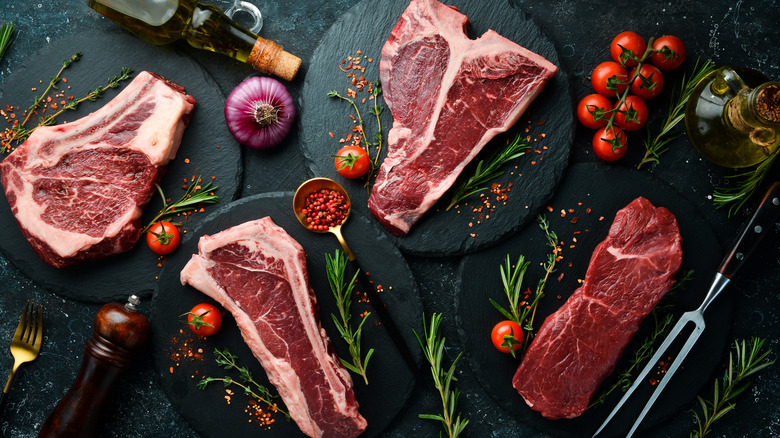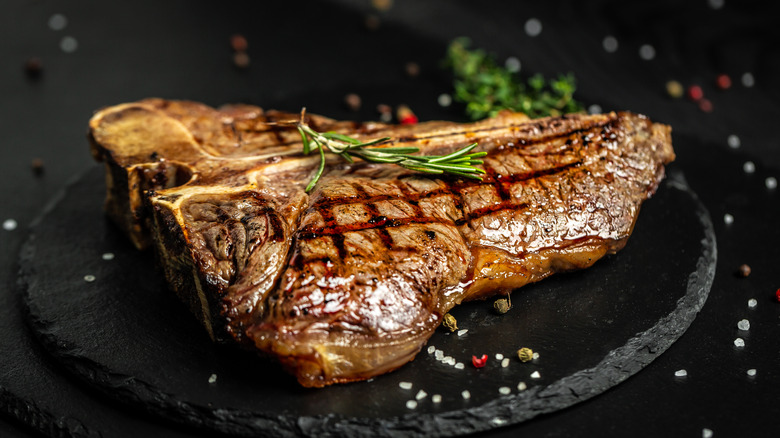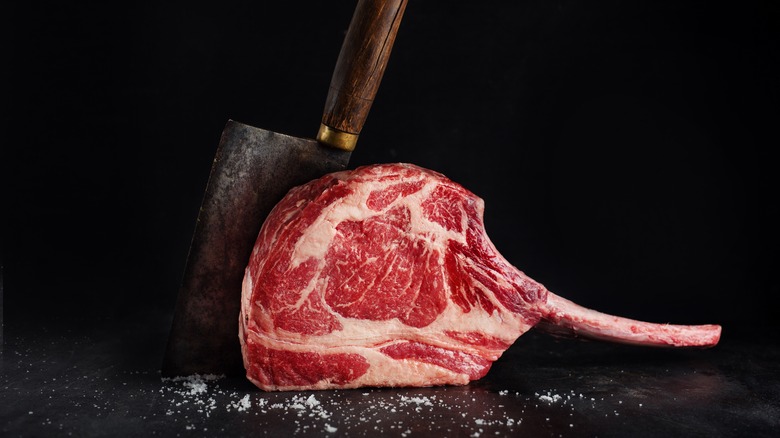What Steak Cuts Typically Include Bones?
Beef is one of the most popular meats eaten around the world. Around 14.24 kilograms (31.39 pounds) of beef were consumed per person in 2022, with Argentina consuming the most beef in 2022 at 36.89 kilograms (81.33 pounds) per person, according to the Organization for Economic Cooperation and Development (OECD). The United States came in second for the most beef consumption in 2022, with 25.34 kilograms (55.87 pounds) eaten per person. Overall, the OECD estimates that the amount of beef consumed will increase to about 14.44 kilograms (31.83 pounds) per person by 2029.
Perhaps one reason beef is such a popular meat is that it's extremely versatile. There are eight general cuts of beef: shank, or thigh; round, or back end; flank, or abdomen; loin; plate, or belly; rib; brisket, or chest; and chuck, or shoulder, per MasterClass. Of course, some cuts of steak contain bone and are served that way. However, contrary to popular belief, leaving the bone in doesn't actually add flavor (via Steak School).
The biggest benefit to leaving the bone in a cut of steak is that the bone actually helps "insulate" the meat and keeps it at a lower temperature, compared to a steak cooked without the bone. This helps the meat release less moisture and stay plump and juicy. So, what cuts of steak typically include bones?
Porterhouse, T-bone, filet mignon, and strip steaks may be served with bones
There are several cuts of steak that typically include bone. Two of the most common are a T-bone steak and a Porterhouse steak, per MasterClass. Both cuts come from the short loin region of a cow; however, a T-bone steak is cut from the front of that region, while a Porterhouse steak is cut from the back of that region.
The biggest difference this makes between the two cuts is that a T-bone steak must be a least a half-inch thick, and a Porterhouse steak must be at least an inch and a quarter thick, so a Porterhouse cut will be larger than a T-bone, according to the United States Department of Agriculture (USDA). Therefore, all T-bone steaks are also Porterhouse steaks, but a Porterhouse steak can never be a T-bone steak.
Both a T-bone and Porterhouse steak will be tender and have sufficient fat marbling (via MasterClass). Furthermore, both steaks are technically made up of two cuts: a smaller tenderloin (aka filet mignon) and a larger strip steak (aka New York Strip), per Omaha Steaks. Because of this, some strip steaks and cuts of filet mignon can be served with the bone intact if preferred, according to the Kansas City Steak Company.
Bones can also be found in tomahawk, ribeye, short ribs, and more
Other cuts of steak may also include bones, including top loin steak, short ribs, chuck arm steak and roast, chuck blade steak and roast, beef shank cross cut, the small end of a rib roast, the large and small end of a rib steak, a cross cut of a beef shank, cross rib pot roast, and sirloin steak with pin bone, flat bones, round bones, and wedge bone, according to the University of Nebraska-Lincoln's Institute of Agriculture and Natural Resources. A popular cut of steak, ribeye can also be served with bones (via Omaha Steaks).
Ribeye is cut from the rib section, which is between the chuck and loin regions and just in front of the area where T-bone and Porterhouse are cut from. Once again, the inclusion of the bone in ribeye helps the meat stay plump and juicy by "insulating" the meat (via Steak School). One unique cut of steak that includes bones is the tomahawk steak, which is named after the tomahawk axe, per Omaha Steaks. Tomahawk steaks come from the same section as ribeye steaks, but the difference is that tomahawk steaks feature a long, intact bone that sticks out.


